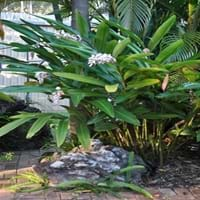Life Span
Perennial
Perennial
Type
Bulb or Corm or Tuber
Tender Perennial
Origin
South America
Southeastern Asia, India, Melanesia, Micronesia
Types
Pamianthe cardenasii , Pamianthe parviflora , Pamianthe peruviana
Variegata Dwarf, Variegata Chinese Beauty
Number of Varieties
Not Available
Habitat
All sorts of environments
Tropical regions
USDA Hardiness Zone
8-10
8-15
Sunset Zone
21,22
H1, H2, 14, 15, 16, 17, 18, 19, 20, 21, 22, 23, 24
Habit
Clump-Forming
Clump-Forming
Flower Color
White
White, Red, Light Pink
Flower Color Modifier
Bicolor
Multi-Color
Fruit Color
Green
Not Available
Leaf Color in Spring
Dark Green
Dark Green
Leaf Color in Summer
Light Green
Dark Green
Leaf Color in Fall
Several shades of Green
Dark Green
Leaf Color in Winter
Light Green
Dark Green
Leaf Shape
Strap shaped
Lance shaped
Plant Season
Spring, Summer, Fall
Spring, Summer, Fall, Winter
Sunlight
Partial Sun, Partial shade
Partial Sun, Partial shade
Type of Soil
Loam, Sand
Loam, Sand
The pH of Soil
Acidic, Neutral, Alkaline
Acidic, Neutral
Soil Drainage
Average
Average
Bloom Time
Spring, Late Spring, Early Summer, Summer, Late Summer
Late Spring, Early Summer, Summer
Tolerances
Drought
Drought
Where to Plant?
Ground, Pot
Container, Ground, Pot
How to Plant?
Offsets
By dividing rhizomes, tubers
Plant Maintenance
Medium
Medium
Watering Requirements
Keep the ground moist but not water-logged
Requires plenty of water during the growing season
In Summer
Lots of watering
Lots of watering
In Spring
Moderate
Moderate
In Winter
Average Water
Average Water
Soil pH
Acidic, Neutral, Alkaline
Acidic, Neutral
Soil Type
Loam, Sand
Loam, Sand
Soil Drainage Capacity
Average
Average
Sun Exposure
Partial Sun, Partial shade
Partial Sun, Partial shade
Pruning
Pinch or prune as they grow to promote branching and bushiness, Remove damaged leaves, Remove dead branches, Remove dead leaves, Requires little pruning
Cut off the flower stalks at the base of the plant, Remove dead leaves, Remove dead or diseased plant parts
Fertilizers
All-Purpose Liquid Fertilizer, High phosphorus
Apply 8-4-6 amount
Pests and Diseases
Leaf spot, Mosaic viruses
No serious insect or disease problems
Plant Tolerance
Drought
Drought
Flower Petal Number
Single
Single
Fragrant Bark/Stem
No
Yes
Foliage Texture
Coarse
Coarse
Foliage Sheen
Glossy
Glossy
Attracts
Bees, Birds, Bumblebees, Butterflies, Hummingbirds, pollinators
Butterflies, Not Available
Aesthetic Uses
Beautification, Bouquets, Ornamental use, Showy Purposes
Showy Purposes
Beauty Benefits
No Beauty Benefits
Good for skin
Environmental Uses
Air purification
Air purification
Medicinal Uses
No Medicinal Use
Antiulcerogenic, Diuretic, Hypotensive
Part of Plant Used
Not Available
Leaves, Rhizomes
Other Uses
Beneficial species for attracting pollinators, Decoration Purposes
Can be made into a herbal tea, Leaves used for wrapping zongi, Used to flavour noodles, Used to wrap mochi rice cakes
Used As Indoor Plant
No
Yes
Used As Outdoor Plant
Yes
Yes
Garden Design
Bog Garden, Container, Feature Plant, Foundation, Mixed Border, Water Gardens
Container, Cutflower, Mixed Border, Screening / Wind Break, Tropical
Botanical Name
HYMENOCALLIS longipetala
ALPINIA zerumbet
Common Name
Peruvian Daffodil, Spiderlily
Shell Ginger
In Hindi
peruvian daffodil
Shell Ginger
In German
peruvian daffodil
Shell Ginger
In French
peruvian daffodil
Shell Ginger
In Spanish
Pamianthe
Shell jengibre
In Greek
peruvian daffodil
Shell Τζίντζερ
In Portuguese
peruvian daffodil
Shell Ginger
In Polish
peruvian daffodil
Shell Imbir
In Latin
peruvian daffodil
Crusta Ginger
Phylum
Magnoliophyta
Magnoliophyta
Class
Liliopsida
Lilopsida
Order
Asparagales
Zingiberales
Family
Amaryllidaceae
Zingiberaceae
Clade
Angiosperms, Monocots
Angiosperms, Commelinids, Monocots
Tribe
Clinantheae
Alpinieae
Subfamily
Amaryllidoideae
Alpinioideae
Number of Species
Not Available
Not Available
Season and Care of Peruvian Daffodil and Shell Ginger
Season and care of Peruvian Daffodil and Shell Ginger is important to know. While considering everything about Peruvian Daffodil and Shell Ginger Care, growing season is an essential factor. Peruvian Daffodil season is Spring, Summer and Fall and Shell Ginger season is Spring, Summer and Fall. The type of soil for Peruvian Daffodil is Loam, Sand and for Shell Ginger is Loam, Sand while the PH of soil for Peruvian Daffodil is Acidic, Neutral, Alkaline and for Shell Ginger is Acidic, Neutral.
Peruvian Daffodil and Shell Ginger Physical Information
Peruvian Daffodil and Shell Ginger physical information is very important for comparison. Peruvian Daffodil height is 61.00 cm and width 61.00 cm whereas Shell Ginger height is 180.00 cm and width 120.00 cm. The color specification of Peruvian Daffodil and Shell Ginger are as follows:
Peruvian Daffodil flower color: White
Peruvian Daffodil leaf color: Dark Green
Shell Ginger flower color: White, Red and Light Pink
- Shell Ginger leaf color: Dark Green
Care of Peruvian Daffodil and Shell Ginger
Care of Peruvian Daffodil and Shell Ginger include pruning, fertilizers, watering etc. Peruvian Daffodil pruning is done Pinch or prune as they grow to promote branching and bushiness, Remove damaged leaves, Remove dead branches, Remove dead leaves and Requires little pruning and Shell Ginger pruning is done Cut off the flower stalks at the base of the plant, Remove dead leaves and Remove dead or diseased plant parts. In summer Peruvian Daffodil needs Lots of watering and in winter, it needs Average Water. Whereas, in summer Shell Ginger needs Lots of watering and in winter, it needs Average Water.





